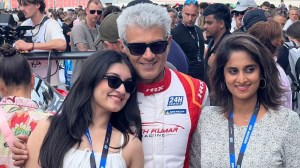Apple of Newton’s eye blossoms in Pune
PUNE, Sept 30: ISAAC Newton's legacy is alive in a small fruit garden in the heart of a scientific institution here. A falling apple woul...

PUNE, Sept 30: ISAAC Newton’s legacy is alive in a small fruit garden in the heart of a scientific institution here. A falling apple would have the remotest connection with a theory on gravity, one would have thought. Many centuries later, fewer believed the climate of Pune could foster the growth of apples. But then, the Eureka!’ experience manifests itself in the strangest of ways.
When Dr Jayant Narlikar, director, Inter University Centre for Astronomy and Astrophysics (IUCAA) obtained three saplings grafted from the historic apple tree from Isaac Newton’s garden in the United Kingdom last year, and planted them at IUCAA on July 9, 1997, experts were sceptical about the very survival of the trees.
A year down the road, not only have the three saplings grown and flourished but one of them has even begun to bear fruit, much to the scientist’s delight.
Pune is one of the few cities in the world to have clones of the original Newton’s tree, growing with the fruit, to add to its honour.
The two applesthat are the cynosure of all eyes at IUCAA were noticed by the scientists a fortnight ago. As the fruits grew in size, so did the excitement.
“Pune does not have a climate conducive to apples,” informs T Sahai, Senior Administrative Officer at IUCAA.“To ensure the mere survival of the three saplings we had to take special care. The main thing was to protect them from direct sunlight and heat. Also, they needed to have the right amount of manure and water. Their branches were pruned regularly to ensure that there was no excess burden on the plant.”
The saplings were planted away from one another in varying conditions of shade and soil to study which conditions were most suitable for their growth. The winner appears to be not the sapling planted near Newton’s statue but the one next to Albert Einstein’s.
The saplings were obtained by Dr Jayant Narlikar in July 1997, after he tracked down the original tree, following a tip offered by a fellow scientist who was attending a conference with him inAustralia.
Dr Narlikar had shown a slide of IUCAA to his colleagues that depicted the statue of Isaac Newton beneath a banyan tree, peering quizzically at the plastic apple near its feet.
Narlikar had commented, “Here is Newton trying to find an answer to a very complex problem. No, not the one concerning gravity but the more pertinent problem of how on earth could an apple have fallen from a banyan tree!”
Narlikar spent months tracing and tapping his sources, locating the exact address, obtaining permission for saplings to finally getting the plants in hand.“I was on the verge of giving up when these saplings arrived and it was amidst much enthusiasm that we planted them in IUCAA. Some experts were doubtful whether the trees would bear fruit. I am happy their doubts have been put to rest,” adds Narlikar.
Whether the apples are going to turn out a deep red or green, be plucked when ripe, have to be decided upon. For the time being, it’s history in the making at the IUCAA.



- 01
- 02
- 03
- 04
- 05




























